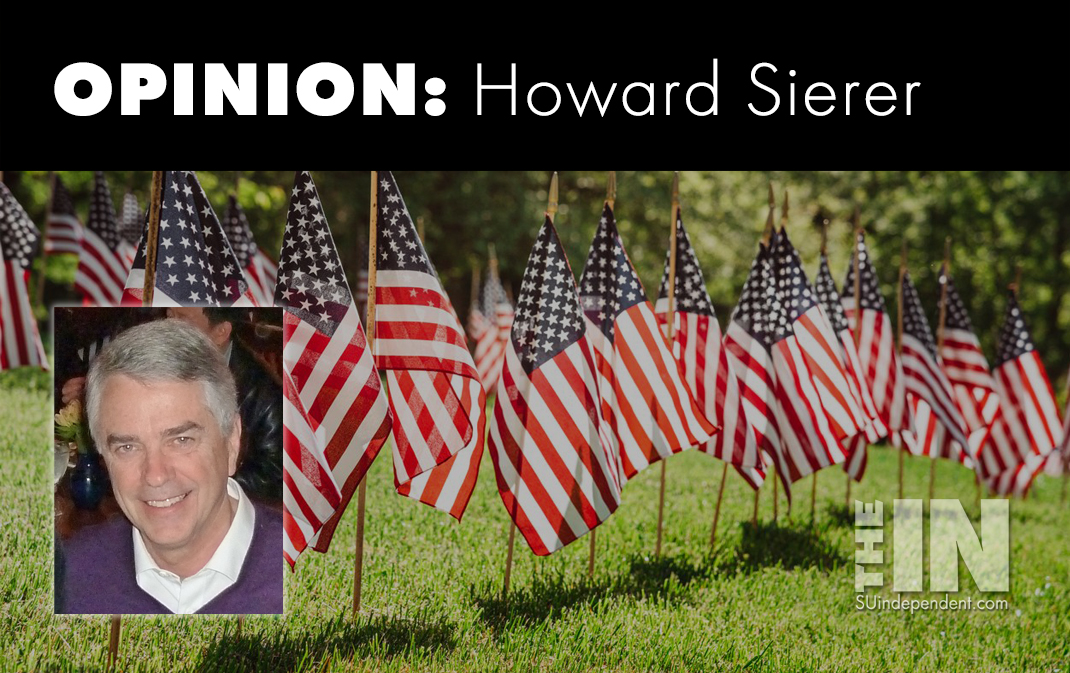
Thinking about My Friends on Memorial Day
– By Howard Sierer –
We celebrate Memorial Day as a national holiday to remember those who, in Abraham Lincoln’s words, gave their “last full measure of devotion.” The Department of Veterans Affairs says that 651,031 members of the armed forces had died in battle as of November 2020, starting with the Revolutionary War and up through today’s Afghanistan conflict.
Our first national Memorial Day was actually called Decoration Day, established in 1868 to encourage citizens to place flowers on the graves of Civil War dead. Called by various names in various parts of the country for almost a century, the name and date were finally established by Congress in 1967.
I went to college with young men who went off to serve in the Viet Nam war, a number as Air Force pilots. Most came home. My thoughts on Memorial Day turn to one friend who eventually came home and four who did not.
Tom Browning bailed out of his F-105 over North Viet Nam on July 8, 1966. He was captured and spent from 1966 to 1973 – 2,412 days – as a “guest” of the North Vietnamese in the notorious “Hanoi Hilton” prisoner of war camp. Released at the end of our military involvement in Viet Nam, Tom is celebrated on Veterans Day, not on Memorial Day, but his seven years as a POW bring him immediately to my mind.
Jim Jefferson flew in the back seat of an F-4 and logged a number of missions over North Viet Nam. On his last mission, May 12, 1967, antiaircraft fire disabled the plane’s ailerons, forcing the pilot to use only the rudder to keep the plane level while heading for the Gulf of Tonkin and a water rescue. They didn’t make it.
When Jim headed off overseas, he asked me drive his 1964 Thunderbird back to his home in Gainesville, Florida. I’ll always remember the drive and I’ll always remember Jim.
Gray Warren trained to fly air defense fighters, the F-102 and subsequently the F-106, and was assigned to the east coast of the U.S. through 1968. As the war in Viet Nam escalated, he was retrained on the F-4. I was living in Los Angeles in 1968 when he spent his last night in the country at my home: I took him to the airport for his flight overseas.
Based at Ubon, Thailand, Gray flew missions over the Ho Chi Minh trail in Laos. On October 26, 1969, he and his co-pilot took a chance by making three consecutive passes over their target. On that third pass, their aircraft disappeared in a fireball. Search and rescue efforts detected no rescue signals.
Gray had married his high school sweetheart, Julie, and had a young daughter. He was listed as missing in action since there was no way to recover bodies in supposedly neutral Laos. For seven years, Julie remained legally married to Gray, unable to get on with life for her and her daughter.
Tom Daffron flew F-4s out of Cam Ranh Bay. On February 18, 1970, while attacking the notorious Ho Chi Minh trail in Laos, his plane disappeared in a fireball on the ground east of the target. No response to rescue radio signals were received and like many others whose bodies were not recovered at the time, Tom was declared missing in action. His remains were found in 1995 and identified in 1999.
Lance Sijan ejected over North Viet Nam on November 9, 1967, fracturing his skull, mangling his right hand and fracturing his left leg in multiple places. Despite these injuries, he evaded capture for a remarkable 46 days during which he could only move by sliding on his buttocks and back. The North Vietnamese continued to search for him, watching where American search and rescue helicopters were trying to pick him up.
Captured on Christmas Day, emaciated and in poor health, he incapacitated a guard and slipped away into the jungle again. Recaptured several days later, he died in the “Hanoi Hilton” prison camp.
Lance received the Congressional Medal of Honor posthumously in 1976.
While those of us not familiar with combat see extraordinary bravery in the face of danger, many veterans instead describe an overpowering sense of devotion to the buddies who surrounded them on the battlefield, of not wanting to let them down in moments of peril. Patriotism, duty and honor are in there somewhere, but their immediate loyalty was to their friends.
I recount these tragic stories because each of these men were friends. I have felt a lifelong sorrow for their loss and gratitude for their bravery and willingness to serve their country unflinchingly in what was a controversial war. It still is.
I served in the nation’s classified space programs, far from any battlefield. I know I contributed in a small way to the country’s defense. But I’ve often wondered whether I had the “right stuff” to have been ready to offer up my “last full measure of devotion” as these great men did. Having lived a full life that my friends did not, I stand in awe of their very real sacrifice made on behalf of our country, and their fellow soldiers and friends.



